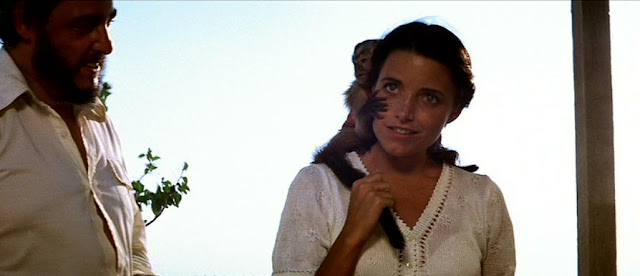The Venus de Milo (130-100 BCE). Image Source: Milos Island.
Except for the Golden Ratio, there is no template for beauty. But you would never know its infinite variety if you looked at the world's movie and media industries. Roughly every half decade, western popular culture has held up an iconic feminine type. The same is true of men. For example, Jake Gyllenhaal and Tobey Maguire shared similar fame and features in the early-to-mid 2000s.
Does a beautiful woman determine the fashion - or do designers set the trend by promoting a particular look? This is a chicken-egg question. I would argue that fashion, movie and media designers do not entirely decide the trends. For a brief window of time, a small bevy of beautiful women somehow channel the aspirations and desires of the Zeitgeist - and then their style becomes a fashion. The ladies who rise to prominence often resemble each other - or they are made up to resemble one another. Below the jump, see a few examples from 1980 to 2000.
Margot Kidder in the Amityville Horror (1979). Image Source: Adventures of a Film Major.
A striking example of a trend-setting pattern is the way in which Boomers' feminist sensibilities favoured whimsical, tomboyish, intelligent brunettes like Margot Kidder, Karen Allen and Debra Winger, from the late 1970s to the early 1980s.
Karen Allen in Raiders of the Lost Ark (1981). Image Source: Gone Movies.
Debra Winger in An Officer and a Gentleman (1982). Image Source: Flixster.
Half decades are marked by particular fixations, be they a specific haircut or hairstyle, a certain manner of dress, a figure type, or artificially enhanced eyes, cheekbones, busts or lips. Again, this is not just a function of the fashion industry or mass media and entertainment industry professionals determining what people want. Some specific aspect of beauty appeals to an audience or consumer demographic at a particular time.
Princess Diana in a Catherine Walker gown (1989): in the mid-to-late 1980s, Princess Diana inspired statuesque fashion plates in glamorous dresses. Image Source: My Daily.
Sean Young in No Way Out (1987). Image Source: cineplex.
From 1980 to 2000, there was a progression in the overall aesthetic. Even the glitzy gowns of the late 1980s featured masculine boxy shoulders and pencil dresses. A friend who is an artist observed to me that over the past five hundred years, the mid-century point features clothing which creates a hooped-out female silhouette (see a discussion (here) comparing hoop skirts in the 1860s (see them here) with hoop skirts the1950s (see here)), while every century has ended with slimmed-down dresses. My friend is certain that women's 2050 fashions will have a hooped-out look, although they may be space pod dress thingies.
Kim Basinger in Chanel, Vogue UK (April 1989). Image Source: devodotcom.
Melanie Griffith. Image Source: List Verse.
Some famous women, like Sophia Loren or Catherine Deneuve, are hailed as 'ageless beauties.' But many actresses reach their zenith over a five year period, and their core careers rarely span more than two decades, as actress Melanie Griffith recently complained. Sexist ageism in Hollywood was the subject of a 2002 documentary, Searching for Debra Winger.
If a beauty becomes the aesthetic 'lightning rod' of her times, she has another concern besides ageing and ageism. As she gets older, she may also channel a different time period, and subliminally appear to be a living anachronism, even if she changes her look to keep up with the times.
Juliette Binoche in Three Colors: Blue (1993). Image Source: posters.
In the early-to-mid 1990s, the Brat Pack grew up; mid-80s' bobs gave way to long-legged and gamine Euro-styled sophisticates who had the same haircuts but made them seem complicated. The brooding yet luminous look was a dark Baroque style of black, red and gold.
Emmanuelle Seigner in Frantic (1988). Image Source: Mimiblix.
Anne Parillaud in Nikita (1990). Image Source: Clothes on Film.
Irène Jacob in The Double Life of Véronique (1991). Image Source: Flickr.
Whitney Houston in The Bodyguard (1992). Image Source: Mirror.
Annabella Sciorra in Romeo is Bleeding (1993). Image Source: Movie clips.
In the late 1990s, the harsher tones from earlier in the decade became even more stark. Bobs became pixie cuts and then disappeared. Bald-headed grrrls met heroin chic in anorexic androgyny; the period celebrated haunted, angry, powerful women. Females sported many masculine affectations by the end of the '90s: tattoos, guns, piercings, body armour - and they became lean-muscled martial artists.
Kate Moss initiated the heroin chic look (mid-1990s). Image Source: citelighter.
Angela Bassett in Strange Days (1995). Image Source: listal.
Demi Moore shaved her head in G.I. Jane (1997). Image Source: allmovie.
Winona Ryder around the mid-late 1990s. Image Source: The Neo-Traditionalist.
Uma Thurman in Gattaca (1997). Image Source: Jeff Wintersinger.
By the end of the Millennium, the trends returned full circle to early 1980s' cyberpunk. In a twenty year period, sci-fi revealed a nearly complete masculinization of the female model.
Sean Young in Blade Runner (1982). Image Source: trendipia.
Carrie Anne Moss in The Matrix (1999). Image Source: matrixfans.







































No comments:
Post a Comment